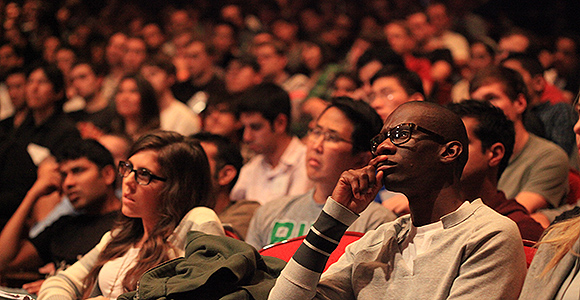
Audience at Y Combinator’s Startup School in 2011 at Stanford University. (Photo Credit: Robert Scoble/Flickr)
Latinos account for nearly 30 percent of the population of Silicon Valley, yet make up only three percent of the local high-tech workforce, according to the Hispanic Foundation of Silicon Valley (HFSV).
Why the gap?
“It’s about education levels,” said HFSV’s President and CEO Ron Gonzales. “It’s about not having enough Latinos in the funnel in terms of college graduation as well as college graduates with STEM-related degrees.”
Gonzales thinks the numbers are even worse as the companies disclosing employment data do not specify the ethnic breakdown per job and many counted in the report work in administration or support jobs. He thinks the number of Latinos with actual high-tech jobs may be as low as one percent.
That’s why HFSV is partnering with the Silicon Valley Education Foundation and ALearn to offer a math and algebra program to properly prepare middle school students for high school and beyond. The Foundation is also working on “Latinos in Technology Initiative,” a partnership with local high-tech companies to increase the number of college-bound Latinos majoring in STEM-related degrees.
Judy Miner, President of Foothill College, is also working on increasing the Latino presence in Silicon Valley. But first, she pointed out four areas to help students succeed: “Students need to be motivated, they need to be prepared, there needs to be opportunities for them and there needs to be the means for the students to take advantage of those opportunities.”
Miner was part of the President’s Council of Advisors on Science and Technology (PCAST) and helped produce Engage to Excel: Producing One Million Additional College Graduates with Degrees in Science, Technology, Engineering, and Mathematics.
Through its Science Learning Institute, Foothill College has created programs to encourage under-represented populations to enter STEM fields. Each summer, it offers STEM summer camps to approximately 1,000 high school students as well as internships including the UCSF Diversity Scholars Program, a five-week summer internship where students learn laboratory techniques in a range of STEM topics, and participates in Year Up, an organization that trains at-risk youth in urban areas for jobs in high tech, while earning college credit.
But Miner believes that it takes more than exposing students to the possibilities of higher education, families and parents must also be engaged to make sure there is a support system for the student. In 2010, Foothill College opened the Family Engagement Institute to help parents and families promote school and workforce readiness and pathways to college. The College also sponsors a yearly Physics Show for local schoolchildren to show how physics affects their everyday lives. More than 10,000 children attend.
Showing under-represented populations in Silicon Valley the value of a STEM-related education will help encourage and prepare them to compete for high-skilled, high-paying jobs in their own backyard. And, allowing families to prosper in their own communities will not only strengthen the regional economy, but also create a tradition of prosperity. The work of HFSV and Foothill College are good examples of the workforce development priorities in the California Economic Summit’s Roadmap to Shared Prosperity for California.
Gonzales summed up why their work is important: “It’s about opening their eyes about what happens here and more importantly, what it’s going to take for them to survive here if they wish to live in a beautiful place like Silicon Valley and prosper along with everyone else.”

